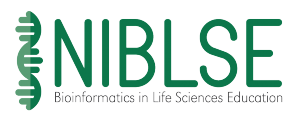Resources
Bioinformatics - Investigating Sequence Similarity
Author(s): Adam Kleinschmit1, Benita Brink1, Steven Roof2, Carlos Christopher Goller3, Sabrina Robertson3
1. Adams State University 2. Fairmont State University 3. North Carolina State University
2035 total view(s), 305 download(s)
Bundle(ZIP | 2 MB)
- License terms
Description
The following modules are from a pre-print version of the "Sequence Similarity: An inquiry based and "under the hood" approach for incorporating molecular sequence alignment in introductory undergraduate biology courses" learning resource accepted for publication in CourseSource, which is currently in press.
This laboratory module, leads introductory biology students in the exploration of a basic set of bioinformatics concepts and tools. The exercise utilizes simple paper models to help students understand matrices and algorithms prior to use of web-based computational tools. Students start the module by defining sequence similarity and then investigating how similarity can be quantitatively compared between two similar length proteins using a BLOSUM scoring matrix. Students then consider finding local regions of similarity between a sequence query and subjects within a large database using BLAST. Lastly, students practice accessing FASTA formatted sequence information via NCBI databases as they collect sequences for a multiple sequence alignment in order to generate a phylogenetic tree.
Notes
The learning resource was modified to provide further background information for the reader in addition to an expanded paper-based distance matrix exercise and a set of inquiry questions now bookend the resource to promote student engagement and application of the concepts explored.
This version includes an updated author list.
Cite this work
Researchers should cite this work as follows:
- Adam Kleinschmit, Brink, B., Roof, S., Goller, C. C., Robertson, S. (2018). Bioinformatics - Investigating Sequence Similarity. NIBLSE Incubator: Bioinformatics - Investigating Sequence Similarity, (Version 4.0). QUBES Educational Resources. doi:10.25334/Q4VM1P
